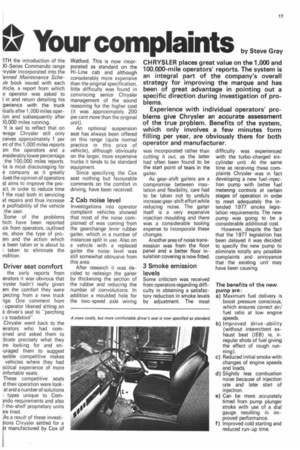14 Your complaints 'ITH the introduction of the )0-Series Commando
Page 139

If you've noticed an error in this article please click here to report it so we can fix it.
range irysler incorporated into the 'anned Maintenance Schetle book issued with each shicle, a report from which
e operator was asked to I in and return detailing his :perience with the truck itially after 1,000 miles operion and subsequently after )0,000 miles running.
It is sad to reflect that on rerage Chrysler still only ceives approximately 1 per int of the 1 MOO miles reports )rn the operators and a snsiderably lower percentage the 100,000 miles reports. us is most discouraging for e company as it greatly ties the opinion of operators id aims to improve the proJet, in order to reduce time f the road both in servicing id repairs and thus increase e profitability of the vehicle the user.
Some of the problems hich have been reported ick from operators, outlined ire, show the type of proem and the action which is been taken or is about to taken to eliminate the indition.
Driver seat comfort
the early reports from wrators it was obvious that irysler hadn't really given em the comfort they were pecting from a new truck Ige. One comment from I operator likened sitting on a driver's seat to "perching a toadstool".
Chrysler went back to the )erators who had corn3ined and asked them to dicate precisely what they 3re looking for and enuraged them to suggest issible competitive makes vehicles where they had actical experience of more .mfortable seats.
These competitive seats d their operation were lookat and a number of solutions types unique to Cornindo requirements and also I-the-shelf proprietary units ?se tried.
As a result of these investitions Chrysler settled for a at manufactured by Cox of Watford. This is now incorporated as standard on the Hi-Line cab and although considerably more expensive than the original specification, little difficulty was found in convincing senior Chrysler management of the sound reasoning for the higher cost (it was approximately 200 per cent more than the original unit).
An optional suspension seat has always been offered on this range (quite normal practice in this price of vehicle), although obviously on the larger, more expensive trucks it tends to be standard equipment.
Since specifying the Cox seat nothing but favourable comments on the comfort in driving, have been received.
2 Cab noise level
Investigations into operator complaint vehicles showed that most of the noise complained of was coming from the gearchange lever rubber gaiter, which in a number of instances split in use. Also on a vehicle with a replaced gaiter the noise level was still somewhat obtrusive from this area.
After research it was decided to redesign the gaiter by thickening the section of the rubber and reducing the number of convolutions. In addition a moulded hole for the two-speed axle wiring was incorporated rather than cutting it out, as the latter had often been found to be the start point of tears in the gaiter.
As gear-shift gaiters are a compromise between insulation and flexibility, care had to be taken not to unduly increase gear-shift effort while reducing noise. The gaiter itself is a very expensive injection moulding and there was a considerable tooling expense to incorporate these changes.
Another area of noise transmission was from the floor panel and a better floor insulation covering is now fitted.
3 Smoke emission levels
Some criticism was received from operators regarding difficulty in obtaining a satisfactory reduction in smoke levels by adjustment. The most difficulty was experienced with the turbo-charged sixcylinder unit. At the same time as receiving these complaints Chrysler was in fact developing a new fuel-injection pump with better fuel metering controls at certain stages of operation in order to meet adequately the intended 1977 smoke legislation requirements. The new pump was going to be a considerable additional cost.
However, despite the fact that the 1977 legislation has been delayed it was decided to specify the new pump to eliminate totally any possible complaints and annoyance that the existing unit may have been causing.
The benefits of the new pump are: , a) Maximum fuel delivery is boost pressure conscious, which ensures correct air/ fuel ratio at low engine speeds.
b) Improved drive-ability (without intermittent exhaust beat (IEB) ie, irregular shots of fuel giving the effect of rough running).
c) Reduced initial smoke with changes of engine speeds and loads.
d) Slightly less combustion noise because of injection rate and later start of injection.
e) Can be more accurately timed from pump plunger stroke with use of a dial gauge resulting in improved performance.
f) Improved cold starting and reduced run-up time.
























































































































































